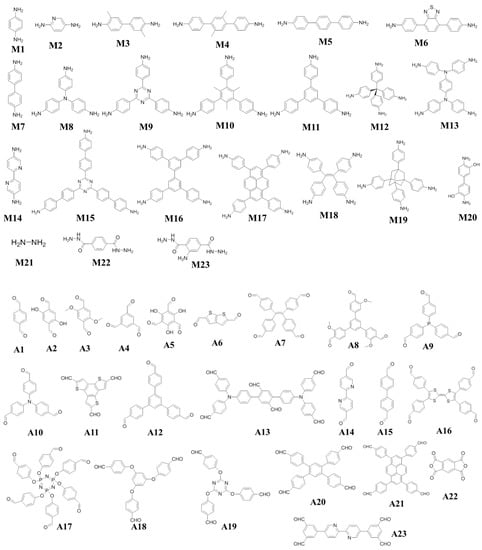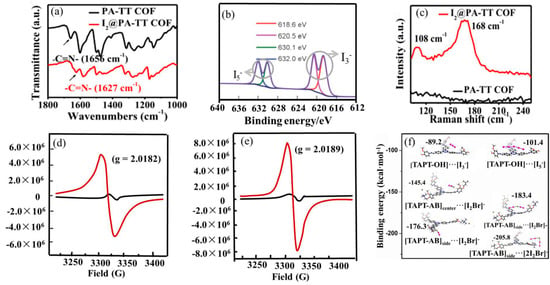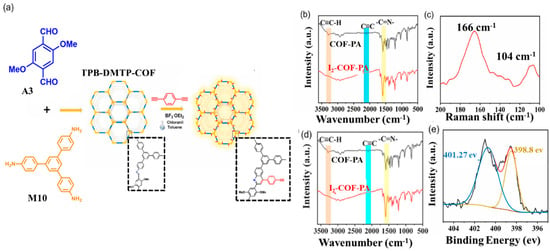You're using an outdated browser. Please upgrade to a modern browser for the best experience.
Please note this is a comparison between Version 1 by Feng Luo and Version 3 by Feng Luo.
Covalent organic frameworks (COFs) are a class of extended crystalline porous polymers that possess unique architectures with high surface areas, long-range order, and permanent porosity. It is known that the possible radioactive iodine species in the environment are iodate (IO3−), molecular iodine (I2), and organic iodine species (e.g., methyl iodide (CH3I) and ethyl iodide (CH3CH2I)). Different iodine species need to be handled in different ways.
- covalent organic frameworks
- mechanisms
- electron-rich groups
1. Introduction
As one of the clean energy sources that is most likely to replace fossil fuels, nuclear energy plays an extremely important role in many countries [1][2][1,2]. However, the utilization of nuclear energy faces a major problem related to the safe disposal of nuclear waste containing radioactive substances, especially radioactive iodine, which is difficult to handle in the actual environment due to its volatility, strong fluidity, and fast diffusion [3][4][3,4]. The main radioisotopes for iodine are 129I and 131I. 129I is considered to be one of the most dangerous byproducts in nuclear waste due to its long radioactive half-life (1.57 × 107 years) and negative effects on human metabolic processes (it can be accumulated in the human thyroid gland, causing serious diseases) and the environment. Additionally, although 131I has a short half-life (about 8 days), it is often combined with other hydrocarbons to yield organic compounds, such as methane iodide, which also make it extremely harmful to its ecological surroundings and human health [5][6][7][5,6,7]. If handled improperly, it will seriously restrict the development and application of nuclear energy. On the other hand, radioactive iodine has important applications in the medical field. For example, 125I seed implantation is widely applied in clinical brachytherapy, and 131I can be used for the examination of thyroid function and the treatment of malignant tumors [8]. In this regard, it is urgent to develop a highly efficient method to capture and store radioactive iodine.
It is known that the possible radioactive iodine species in the environment are iodate (IO3−), molecular iodine (I2), and organic iodine species (e.g., methyl iodide (CH3I) and ethyl iodide (CH3CH2I)). Different iodine species need to be handled in different ways [9][10][11][9,10,11]. Among them, volatile molecular iodine (I2) is the main chemical form of radioiodine in fission, which is of major concern due to its chemical and biological toxicities. Given this, developing functional adsorbents to efficiently capture radioiodine vapor is extremely significant. The traditional adsorbents developed for radioactive molecular iodine capture and storage are mainly inorganic adsorbents, such as zeolites, Ag-doped silica aerogels, clay, and activated carbon [12][13][14][15][16][12,13,14,15,16]. However, these inorganic adsorbents normally have low efficiency, high cost, instability toward moisture, or demanding application scenarios. For instance, the theoretical and practical adsorption capacities of Ag-doped silica aerogel are 1.18 g·g−1 and 0.10–0.31 g·g−1, respectively, and are far from meeting actual requirements [17]. For the elimination of radioiodine in complicated conditions, it is necessary to design novel materials with high sorption capacity, high stability, high selectivity, and low cost.
In recent years, the application of metal—organic frameworks (MOFs) and porous organic polymers (POPs) for iodine capture has attracted great interest. MOFs have been widely studied as adsorbents for molecular iodine because of their high surface area [18][19][20][21][22][23][24][25][18,19,20,21,22,23,24,25]. Yet, the stability of MOFs at high temperatures and in solution are generally poor, which limits their practical application. POPs, including hypercrosslinked polymers (HCPs) [26][27][28][26,27,28], conjugated microporous polymers (CMPs) [29][30][31][32][29,30,31,32], porous aromatic frameworks (PAFs) [33][34][35][33,34,35], and covalent organic frameworks (COFs) [36], are another type of porous material with higher stability that are connected via strong covalent bonds. They have been found to have a high potential for capturing and storing iodine, and many of them have achieved very high iodine capacities. As a unique class of POPs, COFs are distinguished from other POPs by their highly ordered internal structures and crystallinities, as well as their advantages of easy functionalization, low density, large BET surface area, intrinsic porosity, and superior chemical/thermal stability [36][37][38][39][36,37,38,39]. The fascinating features of COFs, with their atomically precise integration of scaffolds into 2D/3D topologies, have shown outstanding applications in many fields, such as gas adsorption, sensing, energy conversation, catalysis, etc. Since COF-1 and COF-5 were reported by Yaghi’s group [40] for the first time in 2005, COF materials have become a research focus of the current scientific and technological frontier. Several reviews have summarized the synthesis, characterization, and application of COFs [41][42][43][44][45][46][41,42,43,44,45,46]. However, there is still lack of reviews systematically focusing on the COFs applied in the iodine capture area. In 2017, Zhao et al. first applied COFs in the field of iodine capture and achieved remarkable results [47]. They reported a heteropore 2D COF (SIOC-COF-7), which showed an I2 adsorption capacity of 4.81 g·g−1 due to its large inner cavities, and a special structure of porous shells. This 2D COF also showed good adsorption performance towards dissolved I2 in the solution phase. Since then, many successful examples of COFs constructed by various monomers and functional building blocks (Scheme 1) have been reported and applied in the iodine capture area in recent years. These COFs, with their specific pore environments and tunable chemistry, can be easily functionalized to acquire effective iodine capture active sites. Although research on the application of COFs in iodine capture is still in its infancy, the unique structural characteristics of these materials, such as their tunable pore size, large surface area, and high crystallinity, make them highly competitive candidates for iodine capture applications.

Scheme 1. Various monomers and functional building blocks (amine groups and aldehyde groups) used for the construction of COFs with iodine capture performance. A—aldehyde; M—amine.
2. Mechanism of Iodine Capture by COFs
2.1. Methods for Studying Adsorption Mechanism
The mechanism of the iodine capture process by COFs mainly consists of physical adsorption, chemical adsorption, and a combination of physical and chemical adsorption. Detailed research on the adsorption mechanism could deepen our understanding of the adsorption process, and thus, promote the theoretical development of the design of COF-based materials with iodine-adsorption properties. In order to explore the adsorption mechanism, samples of COFs loaded with iodine (expressed as I2@COF) are usually studied via FT-IR spectra, Raman spectra, X-ray photoelectron spectroscopy (XPS), electron paramagnetic resonance (EPR), PXRD patterns, transmission electron microscopy (TEM), density functional theory (DFT) calculations, etc. The results of all analyses should be consistent with each other.
The fT-IR spectra of the original samples and those after the loading of iodine were compared. If the characteristic peak positions shift obviously or gradually decrease, or even disappear, it can be proven that there is chemical adsorption caused by the charge-transfer interaction between iodine and electron-rich groups. It can also enable us to infer which structural parts of COFs are related to the adsorption of I2. For example, as shown in Figure 1a, compared with the FT-IR spectra of PA-TT COF, the stretching vibration peak of the -C=N- of I2@PA-TT COF shows a significant shift from 1656 cm−1 to 1627 cm−1, indicating the existence of a chemisorption process caused by the charge-transfer interaction between iodine and the N atom of C=N [48].

Figure 1. (a) FT-IR spectra of PA-TT COF and I2 @PA-TT COF. Reprinted/adapted with permission from Ref. [48]. Copyright (2023), Elsevier. (b) Iodine high-resolution XPS spectra of I2 @TTF-TD-COF. Reprinted/adapted with permission from Ref. [49]. Copyright (2022), Springer-Verlag GmbH. (c) Raman spectra of PA-TT COF and I2 @PA-TTCOF. Reprinted/adapted with permission from Ref. [48]. Copyright (2023), Elsevier. EPR spectra of JUC-560 (d) and JUC-561 (e) before (black curve) and after (red curve) iodine uptake. Reprinted/adapted with permission from Ref. [50]. Copyright (2021), Royal Society of Chemistry. (f) Density functional theory (DFT) calculations of the binding energies of TAPT-OH with I3− and I5−, and TAPT-AB with [I2Br]− and [2I2Br]− located at different positions. Reprinted with permission from Ref. [51]. Copyright (2021), John Wiley and Sons.

X-ray photoelectron spectroscopy (XPS) was conducted to investigate the existing state of iodine captured in COFs (such as I3− and I5−). Before iodine adsorption, the COFs exhibit no obvious peaks. After adsorption, strong peaks appear in the range of 617~620 eV and 629~632 eV for I3− and I5−, respectively (Figure 1b). So, it can be deduced that the absorbed iodine species in COFs existed as polyiodide anions.
Raman spectra were also used to reveal the chemical state of iodine inside the pores of COFs. No obvious peaks are found in COFs before the uptake of iodine. The intense peaks at around 107~109 cm−1 and 167~170 cm−1 emerge for I2@COFs, which can be attributed to the I3− and I5− ions, respectively (Figure 1c). If the peaks of I2, I3−, and I5− can be observed simultaneously, it indicates that elemental iodine and polyiodide anions co-existed in the channels of COFs and the iodine adsorption process was a combination of physisorption and chemisorption. XPS and Raman spectroscopy are the two most effective methods for revealing the chemical state of iodine within the pores of COFs.
The generation of radical cations after iodine adsorption was confirmed via electron paramagnetic resonance (EPR) studies. The original samples show a very weak EPR signal, while there is an approximate increase of two orders of magnitude in paramagnetic intensity after I2 doping. For example, the EPR studies on JUC-560 and JUC-561 show obvious peaks at g = 2.0182 and 2.0189, respectively (Figure 1d,e), clearly indicating the presence of TTF·+ radical cations oxidized by iodine [50].
Density functional theory (DFT) calculations can help researchers gain insight into how the COF frameworks bind iodine. It is well known that the binding energy can remarkably affect iodine capture. Normally, the stronger the interaction between iodine and the adsorption sites, the higher the iodine uptake. The binding energy between the model compounds was calculated via DFT and the corresponding conclusions were obtained by comparing the values. Han’s group [51] calculated the binding energies of the model molecules TAPT-OH and TAPT-AB with the identified iodine species. As shown in Figure 1f, the binding energies between TAPT-AB and [I2Br]−/[2I2Br]− are approximately twice that between TAPT-OH and I3−/I5−, suggesting a stronger affinity of TAPT-AB toward the iodine species. This is consistent with expectations and explains the experimental observations.
PXRD and transmission electron microscopy (TEM) analysis can show whether the crystallinity and morphology of COFs can be maintained throughout the iodine capture process.
2.2. Physical Adsorption of Iodine by COFs
Physical adsorption mainly depends on the surface areas, pore sizes and pore volumes of COFs. Thus, the functionalized architectures are designed to have high specific surface areas, and large pore sizes and pore volumes for efficient physisorption of iodine. For example, Liu et al. designed and synthesized four 2D COFs with different pore sizes for volatile iodine adsorption [52]. Finally, they revealed that the iodine uptake capacity was not only determined by the pore volume but also significantly affected by the intrinsic pore size.
Jiang’ group reported a series of 2D COFs with 1D open channels, which possessed various topologies from hexagonal to tetragonal and trigonal, and were free of specific binding sites and interchannel interpenetration [53]. So, the possibility of charge transfer was excluded. Among these 2D COFs, a TPB-DMTP-COF with a pore size of 3.3 nm and a pore volume of 1.28 cm3·g−1 achieved a remarkable iodine adsorption capacity (6.26 g·g−1) only in physical adsorption, which was driven by van der Waals forces. They proved that I2 capture does not require specific functionalization of the porous skeleton, and that pores of any shape or size can be 100% occupied by physical adsorption. However, its adsorption kinetics were quite slow (0.13 g·g−1·h−1).
2.3. Synergistic Effect of Physical and Chemical Adsorption
As aforementioned, porosity plays an important role in the adsorption of iodine vapor. However, in addition to the amount of adsorption, the adsorption rate is also a significant factor that must be considered. As for the TPB-DMTP-COF, it has an ultrahigh uptake capacity but takes 100 h to reach saturation, which is particularly unfavorable in the case of emergency disasters. Studying only physical adsorption—whereby the iodine uptake capacity of COF materials is determined by pore volume, while the iodine uptake kinetics are determined by pore connectivity and size—limits the application of COFs for iodine capture. The combination of physical and chemical adsorption is of paramount importance in the designed synthesis of COF materials for the capture of radioiodine. It is commonly believed that the interaction of I2 with electron-rich groups (that is, the so-called active sites, such as C=N, -NH2, triazine, pyridine, aromatic rings, etc., which can effectively adsorb electron-deficient I2 via the formation of charge-transfer complexes) and pore channels results in a combination of physical and chemical adsorption for the I2 capture process. The iodine vapor adsorbed into the pores through physical adsorption can readily generate the polyiodide species I3− and I5− due to the strong interactions between the exposed electron-rich groups and I2, implying that a chemisorption process occurs. In the meantime, iodine molecules may fill the remaining pore channels through physical adsorption.
At present, most COFs for iodine capture are based on the above principles. Zhao and co-workers prepared a 2D COF (COF-PA) containing quinoline and phenylacetylene units via post-functionalization of the TPB-DMTP-COF (A3-M10, Figure 2) [54]. XPS and Raman spectra prove that electrons are transferred from electron-rich quinoline units to electron-deficient iodine. They can not only form complex electron-deficient I2 via an electron-rich quinoline unit, but can also adsorb I2 via a chemical reaction with phenylacetylene moieties. Although the surface area and pore size of COF-PA were reduced compared with before functionalization, the adsorption rate was accelerated and the adsorption capacity was still high at low iodine concentrations. Very recently, Zhai et al. discovered two rare cationic COFs, C-TP-PDA-COFs and C-TP-BPDA-COFs (A5-M2, A5-M13), via a post-function process. The cationic C-TP-BPDA-COF exhibits a higher iodine capture value (6.11 g·g−1) than that of neutral COF [55].

Figure 2. (a) Synthetic route. (b) FT-IR spectra. (c) Raman spectra of I2@COF-PA. (d) FT-IR spectra of COF-PA and I2@COF-PA. (e) XPS survey spectrum. Reprinted/adapted with permission from Ref. [54]. Copyright (2021), Elsevier.
The mechanism study found that after the adsorption of iodine by COF, before ionization, only the peak of the neutral iodine molecule existed in the XPS spectra, which suggests typical physical adsorption. However, after ionization, signals for both neutral I2 and anion I3− signals were observed. This indicates the presence of both physical and chemical adsorption. Chang et.al reported that two tetrathiafulvalene (TTF)-based COFs, JUC-560 (A16-M4) and JUC-561(A16-M8), achieve excellent iodine adsorption capacity (8.19 g·g−1) and ultrafast adsorption kinetics (0.70 g·g−1·h−1) [50]. These architectures are designed to have large specific surface areas for high iodine uptake through the physical process, and plentiful TTF functional groups for chemisorption. The synergistic effects of the physisorption and chemisorption processes together contributed to the superior iodine vapor adsorption capacities of the studied COF materials.
The above description indicates that the integration of the virtues of physical and chemical adsorption is of paramount importance in the designed synthesis of porous materials for the very challenging capture of radioiodine.
